April/2023 Latest Braindump2go MS-720 Exam Dumps with PDF and VCE Free Updated Today! Following are some new Braindump2go MS-720 Real Exam Questions!
QUESTION 30
You have a Microsoft Teams Phone deployment.
You have a PBX that connects to the PSTN by using an E1/T1 Primary Rate interface (PRI).
You plan to migrate to Direct Routing by using the existing PSTN services.
What should you install upstream of the PBX?
A. a physical Session Border Controller (SBC)
B. an FXO SIP Analog Telephony Adapter (ATA)
C. a virtual Session Border Controller (SBC)
D. a Session Border Controller (SBC) in Azure
Answer: A
Explanation:
Local PBX might have the ISDN connectivity hosted, in this case no need to be a physical SBC, so a virtual SBC = Azure SBC can be SIP trunked in between Teams Tenant and PBX.
QUESTION 31
You have a Microsoft Teams Phone deployment.
You are deploying a new remote site.
You have a Session Border Controller (SBC) that has an E1/T1 Primary Rate Interface (PRI) deployed to the remote site.
You plan to deploy a Survivable Branch Appliance (SBA) to ensure PSTN connectivity.
Which type of endpoints is supported by the SBA?
A. call queues in Microsoft Teams
B. audio conferencing in Microsoft Teams
C. Microsoft Teams panels
D. Microsoft Teams Windows desktops
Answer: D
Explanation:
The SBA feature is supported on the following Microsoft Teams clients:
Microsoft Teams Windows desktop
Microsoft Teams macOS desktop
Teams for Mobile
Teams Phones
Reference:
https://docs.microsoft.com/en-us/microsoftteams/direct-routing-survivable-branch-appliance
QUESTION 32
You have a Microsoft Teams Phone deployment.
You need to implement Local Media Optimization for Direct Routing users at a site.
Users at the site frequently perform the following actions:
– Park calls.
– Place calls on hold.
– Transfer calls to other users.
– Escalate calls to conference calls.
Which action will be affected by implementing Local Media Optimization?
A. Park calls.
B. Transfer calls to other users.
C. Escalate calls to conference calls.
D. Place calls on hold.
Answer: C
Explanation:
Call escalations from 1 to 1 call between internal customers to multiparty call with external customer/resource result in dropped calls
Held call when resumed, call does not disconnect, call works through Proxy SBC but LMO will stop working for this call.
https://docs.microsoft.com/en-us/microsoftteams/direct-routing-media-optimization#known-issues
QUESTION 33
You have a Microsoft Teams Phone deployment that uses Direct Routing.
You need to implement Local Media Optimization.
In the Microsoft Teams admin center, you configure the external trusted IP addresses and define the network regions, network sites, and network subnets.
What should you do next?
A. Define a voice route.
B. Create a trunk translation rule.
C. Assign Session Border Controllers (SBCs) to sites.
D. Modify the default emergency calling policy.
Answer: C
Explanation:
https://docs.microsoft.com/en-us/microsoftteams/direct-routing-media-optimization-configure
QUESTION 34
You have a Microsoft Teams Phone deployment.
You need to implement PSTN connectivity by using Direct Routing.
What are three requirements for the implementation? Each correct answer presents part of the solution.
NOTE: Each correct selection is worth one point.
A. a Session Border Controller (SBC) that uses a hostname in the onmicrosoft.com domain
B. a firewall rule that opens a TCP signaling port to Microsoft Teams
C. a public DNS entry that maps the FQDN of the Session Border Controller (SBC) to a public IP address
D. a firewall rule that opens a UDP signaling port to Microsoft Teams
E. a Teams-certified Session Border Controller (SBC)
Answer: BCE
Explanation:
https://docs.microsoft.com/en-us/microsoftteams/direct-routing-plan
QUESTION 35
You are planning a Microsoft Teams Phone deployment that will use Direct Routing.
You need to allow traffic from Microsoft 365 to a Session Border Controller (SBC).
Which IP address ranges should you allow through the firewall?
A. 8.8.8.8/32 and 4.4.2.2/32
B. 52.112.0.0/14 and 52.120.0.0/14
C. 132.245.0.0/16 and 40.104.0.0/15
D. 10.10.0.0/24 and 10.11.0.0/24
Answer: B
Explanation:
https://docs.microsoft.com/en-us/microsoft-365/enterprise/urls-and-ip-address-ranges?view=o365-worldwide
QUESTION 36
Note: This question is part of a series of questions that present the same scenario. Each question in the series contains a unique solution that might meet the stated goals. Some question sets might have more than one correct solution, while others might not have a correct solution.
After you answer a question in this section, you will NOT be able to return to it. As a result, these questions will not appear in the review screen.
You need to create a new call queue to route calls to support agents. The support agents must be able to see their call queue history and the shared transcribed voicemail. The solution must minimize administrative effort.
Solution: You configure the call queue to use a Microsoft 365 group.
Does this meet the goal?
A. Yes
B. No
Answer: A
Explanation:
https://www.orbid365.be/shared-voicemail-arrives-in-teams/
QUESTION 37
Note: This question is part of a series of questions that present the same scenario. Each question in the series contains a unique solution that might meet the stated goals. Some question sets might have more than one correct solution, while others might not have a correct solution.
After you answer a question in this section, you will NOT be able to return to it. As a result, these questions will not appear in the review screen.
You need to create a new call queue to route calls to support agents. The support agents must be able to see their call queue history and the shared transcribed voicemail. The solution must minimize administrative effort.
Solution: You set the routing method for the call queue to Attendant routing.
Does this meet the goal?
A. Yes
B. No
Answer: B
Explanation:
call queue to Attendant routing does not meet the requirement. but configuring groups to channel does.
QUESTION 38
Note: This question is part of a series of questions that present the same scenario. Each question in the series contains a unique solution that might meet the stated goals. Some question sets might have more than one correct solution, while others might not have a correct solution.
After you answer a question in this section, you will NOT be able to return to it. As a result, these questions will not appear in the review screen.
You need to create a new call queue to route calls to support agents. The support agents must be able to see their call queue history and the shared transcribed voicemail. The solution must minimize administrative effort.
Solution: You redirect calls for the call queue to a shared voicemail box.
Does this meet the goal?
A. Yes
B. No
Answer: B
Explanation:
Teams Channel will be the correct answer to review the call queue and common voicemail.
QUESTION 39
Note: This question is part of a series of questions that present the same scenario. Each question in the series contains a unique solution that might meet the stated goals. Some question sets might have more than one correct solution, while others might not have a correct solution.
After you answer a question in this section, you will NOT be able to return to it. As a result, these questions will not appear in the review screen.
Your company uses Microsoft Teams Calling Plans.
The company acquires a small development team. Currently, users on the team have their own direct inward dial (DID) numbers that have PSTN capabilities.
You migrate the users to Teams.
You need to ensure that the users have phone numbers.
Solution: From the Microsoft Teams admin center, you create a new port order.
Does this meet the goal?
A. Yes
B. No
Answer: A
Explanation:
https://docs.microsoft.com/en-us/microsoftteams/phone-number-calling-plans/transfer-phone-numbers-to-teams
QUESTION 40
Note: This question is part of a series of questions that present the same scenario. Each question in the series contains a unique solution that might meet the stated goals. Some question sets might have more than one correct solution, while others might not have a correct solution.
After you answer a question in this section, you will NOT be able to return to it. As a result, these questions will not appear in the review screen.
Your company uses Microsoft Teams Calling Plans.
The company acquires a small development team. Currently, users on the team have their own direct inward dial (DID) numbers that have PSTN capabilities.
You migrate the users to Teams.
You need to ensure that the users have phone numbers.
Solution: You run the New-CsHybridTelephoneNumber cmdlet.
Does this meet the goal?
A. Yes
B. No
Answer: B
QUESTION 41
Note: This question is part of a series of questions that present the same scenario. Each question in the series contains a unique solution that might meet the stated goals. Some question sets might have more than one correct solution, while others might not have a correct solution.
After you answer a question in this section, you will NOT be able to return to it. As a result, these questions will not appear in the review screen.
Your company uses Microsoft Teams Calling Plans.
The company acquires a small development team. Currently, users on the team have their own direct inward dial (DID) numbers that have PSTN capabilities.
You migrate the users to Teams.
You need to ensure that the users have phone numbers.
Solution: From the Microsoft Teams admin center, you place a new order for service numbers.
Does this meet the goal?
A. Yes
B. No
Answer: B
Explanation:
https://docs.microsoft.com/en-us/microsoftteams/getting-service-phone-numbers
QUESTION 42
Drag and Drop Question
From Voice in the Microsoft Teams admin center, you select Operators and add an operator.
You need to enable users for Microsoft Teams Phone.
Which three actions should you perform in sequence? To answer, move the appropriate actions from the list of actions to the answer area and arrange them in the correct order.
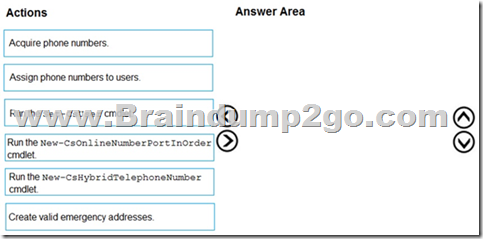
Answer:
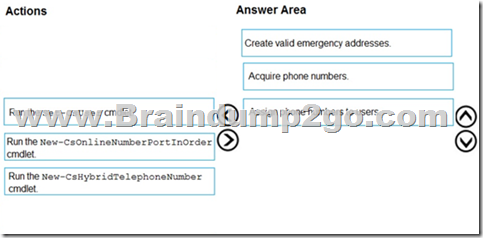
Explanation:
https://docs.microsoft.com/en-us/microsoftteams/operator-connect-configure
QUESTION 43
Your company receives PSTN services in Microsoft Teams through a derived Direct Routing trunk from a telephone carrier.
The carrier becomes an operator in the Operator Connect program.
You need to migrate the users to Operator Connect.
Which three actions should you perform? Each correct answer presents part of the solution.
NOTE: Each correct selection is worth one point.
A. Run the Set-CsUser cmdlet and set the –OnPremLineURI parameter to $null.
B. Run the Grant-CsOnlineVoiceRoutingPolicy cmdlet and set the
–Policyname parameter to Policy1.
C. Run the Grant-CsOnlineVoiceRoutingPolicy cmdlet and set the
–Policyname parameter to $null.
D. Run the Set-CsOnlineVoiceUser cmdlet and set the –TelephoneNumber parameter to each user’s phone number.
E. Run the Set-CsOnlineVoiceUser cmdlet and set the –TelephoneNumber parameter to $null.
F. Run the Set-CsUser cmdlet and set the –OnPremLineURI parameter to each user’s phone number.
Answer: ACD
Explanation:
https://docs.microsoft.com/en-us/microsoftteams/operator-connect-configure
https://docs.microsoft.com/en-us/microsoftteams/assign-change-or-remove-a-phone-number-for-a-user
QUESTION 44
You are enabling users for Direct Routing.
You already assigned licenses to the users.
You need to complete the user setup.
Which two cmdlets should you run? Each correct answer presents part of the solution.
NOTE: Each correct selection is worth one point.
A. Grant-CsOnlineVoiceRoutingPolicy
B. Set-CsOnlineVoiceUser
C. Set-CsUserPstnSettings
D. Grant-CsVoicePolicy
E. Set-CsUser
Answer: AB
Explanation:
https://docs.microsoft.com/en-us/microsoftteams/direct-routing-enable-users
The Set-CsUser cmdlet seems to be used to ensure the user is homed online, which only applies to applies to Skype for Business Server Enterprise Voice enabled users being migrated to Teams Direct Routing.
Since there is no mention of migration from Skype for Business to Teams Direct Routing, I think option E is unnecessary.
https://learn.microsoft.com/en-us/microsoftteams/direct-routing-enable-users
Another note is that Set-CsOnlineVoiceUser may have been replaced with Set-CsPhoneNumberAssignment in the documentation.
QUESTION 45
You have a Microsoft Teams Phone deployment.
You need to provide two users with the ability to share a single phone number for inbound and outbound calling.
What are two ways to achieve the goal? Each correct answer presents a complete solution.
NOTE: Each correct selection is worth one point.
A. call queues
B. call forwarding
C. group call pickup
D. call delegation
E. call park
Answer: AD
Explanation:
Call Queues – You can receive calls and make calls using the Call Queue number.
Group Call – You can only set up incoming calls you cannot call out from group call.
Delegate – You can receive and place call .
QUESTION 46
You have a Microsoft Teams Phone deployment.
You are designing a room that will be used for collaboration.
You need to select a device for the room. The device must meet the following requirements:
– Support video.
– Support one-touch join for meetings.
– Can start new meetings from within the room.
– Support HDMI ingestion of content into Teams.
Which type of device should you select? Each correct answer presents a complete solution.
NOTE: Each correct selection is worth one point.
A. Microsoft Teams Rooms on Android
B. Microsoft Teams panels
C. Microsoft Teams Rooms on Windows
D. Microsoft Surface Hub 2S.
E. Microsoft Teams displays.
Answer: AC
Explanation:
https://docs.microsoft.com/en-us/microsoftteams/rooms/teams-devices-feature-comparison
QUESTION 47
You are deploying Microsoft Teams Phone.
You need to provide a user with a device on his desk that can be used when the user’s computer is turned off. The device must meet the following requirements:
Support calls.
Support video.
Support speed dial.
Display chat history.
Which type of device should you provide?
A. Teams-certified handset
B. Teams display
C. Teams panel
D. Teams Rooms
Answer: B
Explanation:
https://support.microsoft.com/en-us/office/get-started-with-teams-displays-ff299825-7f13-4528-96c2-1d3437e6d4e6
QUESTION 48
You are selecting devices for use in conference rooms. The conference rooms must support two front of room displays.
Which two types of devices meet the requirements? Each correct answer presents a complete solution.
NOTE: Each correct selection is worth one point.
A. Microsoft Teams Rooms on Android
B. Microsoft Teams displays
C. Microsoft Teams audio conference phones
D. Microsoft Teams Rooms on Windows
E. Microsoft Surface Hub 2S
Answer: AD
Explanation:
https://docs.microsoft.com/en-us/microsoftteams/rooms/teams-devices-feature-comparison
QUESTION 49
You are deploying Microsoft Skype for Business 3PIP phones to remote sites for use with Microsoft Teams.
You need to sign each 3PIP phone in to Teams.
What are two possible ways to achieve the goal? Each correct answer presents a complete solution.
NOTE: Each correct selection is worth one point.
A. From the Microsoft Teams admin center, remotely provision a new device.
B. From the device, instruct a local user to sign in from a computer that connects to the device by using a USB cable.
C. From the device, instruct a local user to sign in by using the device itself.
D. From the device, instruct a local user to use the direct inward dial (DID) number and PIN of the assigned account.
E. From the device, instruct a local user to sign in from the web.
Answer: CE
Explanation:
Remote provisioning is only available on native Teams Phones afaik.
QUESTION 50
In the Microsoft Call Quality Dashboard, you discover an increasing trend of poor-quality calls.
You need to implement a solution to identify problematic sites.
Which two actions should you perform? Each correct answer presents part of the solution.
NOTE: Each correct selection is worth one point.
A. Run the CQD User Feedback (Rate My Call) Report.
B. Create a building data file.
C. Upload a file to the Tenant Data Upload page.
D. Upload a file to the Reporting Labels page.
E. Create an endpoint data file.
F. Install the Power BI connector for Call Quality Dashboard (CQD).
Answer: BC
Explanation:
https://docs.microsoft.com/en-us/microsoftteams/cqd-upload-tenant-building-data
QUESTION 51
Your company uses a third-party ticketing system.
You need to send an alert to the ticketing system when an IP phone goes offline.
What should you do?
A. Add a webhook.
B. Create a live events policy.
C. Add a channel alert.
D. Add a configuration profile for the IP phones.
Answer: A
Explanation:
You can also get notifications with an external webhook (optional). Specify an external public webhook URL in the webhook section where a JSON notification payload will be sent.
The notification payload, via webhooks, can be integrated with other systems in your organization to create custom workflows.
https://docs.microsoft.com/en-us/microsoftteams/alerts/device-health-status
QUESTION 52
You have a Microsoft Teams Phone deployment.
You deploy a new network site.
You discover that the new site is not listed in location-based reports. Other sites appear in the reports.
You need to ensure that all the sites appear in the reports.
What should you do?
A. From Network planner in the Microsoft Teams admin center, modify an existing network plan.
B. From Network planner in the Microsoft Teams admin center, add a new persona.
C. From the Microsoft Call Quality Dashboard, select Tenant Data Upload and upload a CSV file that contains the new network site only.
D. From the Microsoft Call Quality Dashboard, select Tenant Data Upload and upload a CSV file that contains all the network sites.
E. From Network planner in the Microsoft Teams admin center, add a new network plan.
Answer: D
Explanation:
https://docs.microsoft.com/en-us/microsoftteams/cqd-upload-tenant-building-data
QUESTION 53
Your company has a Microsoft Teams Phone deployment that uses Direct Routing and a single carrier.
You deploy a new Session Border Controller (SBC) that shows as healthy in the Microsoft Teams admin center.
You place a test call over the new SBC, and the call succeeds.
When you attempt to transfer the call, the transfer fails. A portion of the SIP ladder is shown in the exhibit. (Click the Exhibit tab.)

What is a possible cause of the issue?
A. The SSL certificate of the SBC is incorrect.
B. The Refer on the SBC is misconfigured.
C. NOTIFY is enabled in the SIP options of the SBC.
D. The carrier rejects the format of the forwarded FROM number.
Answer: B
Explanation:
https://docs.microsoft.com/en-us/microsoftteams/troubleshoot/phone-system/direct-routing/issues-with-call-transfers
QUESTION 54
You have a Microsoft Teams Phone deployment that has 10 offices. Each office has a Session Border Controller (SBC).
A user reports that she can make internal calls by using the dial pad, but cannot use the dial pad to make external calls.
What is a possible cause of the issue?
A. The user has the incorrect Teams app setup policy applied.
B. The user has the incorrect voice routing policy applied.
C. The user is missing a validated emergency address.
D. Enterprise Voice is disabled for the user.
Answer: B
Explanation:
Since the dial pad is being used to make internal calls so these are not Teams 1:1 calls. And voice routing policy gets applied to users in Teams.
QUESTION 55
You have a Microsoft Teams Phone deployment.
You are deploying Direct Routing.
All users have a SIP URI in the format of [email protected]. The Session Border Controller (SBC) is named sbc.voice.contoso.com.
When troubleshooting errors on the SBC, you receive the warning shown in the following exhibit.
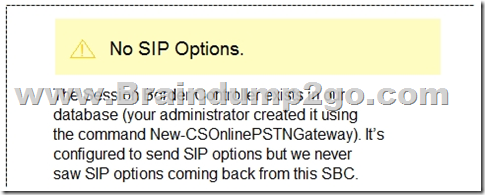
What is a possible cause of the issue?
A. The certificate does not match the FQDN on the SBC.
B. The firewall blocks inbound traffic on port 443 to the SBC.
C. Only TLS 1.0 is enabled on the SBC.
D. Microsoft 365 Phone System licenses are not assigned to the users.
Answer: A
Explanation:
https://docs.microsoft.com/en-us/microsoftteams/troubleshoot/phone-system/direct-routing/sip-options-tls-certificate-issues
QUESTION 56
You have Microsoft Teams Phone handsets.
You need to receive an alert when a handset of an executive goes offline.
What should you do in the Microsoft Team admin center?
A. Create a Teams app setup policy and assign the policy to all executives.
B. Create a configuration profile for IP phones.
C. Register the handsets by using remote provisioning.
D. Modify the device state rule.
Answer: D
Explanation:
https://docs.microsoft.com/en-us/microsoftteams/alerts/device-health-status
QUESTION 57
You have a Microsoft Teams Phone deployment
You use Direct Routing with a Survivable Branch Appliance (SBA) at a site.
The site experiences an extended internet outage.
Which three PSTN calling scenarios are possible during the outage? Each coned answer presents a complete solution.
NOTE: Each correct selection is worth one point.
A. dynamic emergency calling
B. outbound PSTN calls
C. inbound PSTN calls
D. call transfer of PSTN calls
E. hold and resume of PSTN calls
Answer: BCE
Explanation:
When the Microsoft Teams client is in offline mode, the following calling-related functionality is available:
Making PSTN calls via local SBA/SBC with media flowing through the SBC.
Receiving PSTN calls via local SBA/SBC with media flowing through the SBC.
Hold and Resume of PSTN calls.
https://docs.microsoft.com/en-us/microsoftteams/direct-routing-survivable-branch-appliance
QUESTION 58
You have a Microsoft I earns deployment and an existing telephony solution that provides PSTN capability to on premises third-party PBX systems in two separate locations.
You need to implement a redundant PSTN solution for Microsoft Teams Phone. The solution must use the existing telephony earner services. The solution must ensure that outbound calls can be made if a component fails.
Which three components should you implement? Each correct answer presents part of the solution.
NOTE: Each correct selection is worth one point
A. highly available Session Border Controllers (SBCs)
B. calling policies
C. PSTN usages
D. voice routing policies
E. tenant dial plans
Answer: ACD
Explanation:
Reference:
https://docs.microsoft.com/en-us/microsoftteams/direct-routing-voice-routing
QUESTION 59
You have an analog phone system.
You plan to migrate to Microsoft Teams Phone.
You need to recommend devices for common area phones that any user can use.
The solution must meet the following requirements:
– Can access the Teams directory for dial by name.
– Can be administered remotely.
– Can place and pick up calls.
– Support hot desking.
– Minimize costs.
Which type of devices should you recommend?
A. Microsoft-certified 3PIP handsets
B. Microsoft Teams-certified handsets
C. Microsoft Teams Rooms devices
D. Microsoft-certified headsets
E. the existing analog handsels
Answer: D
Explanation:
USB audio and video devices certified for Microsoft Teams.
The peripherals certification program ensures USB peripherals (such as headsets, speakerphones, webcams, and monitors) offer rich audio or video quality.
Certified devices work (plug & play) with no extra configuration required, and offer call control with Microsoft Teams and Skype for Business. The products provide a great experience for end users and administrators.
Certified devices include:

Reference:
https://docs.microsoft.com/en-us/microsoftteams/devices/usb-devices
QUESTION 60
Your company deploys 200 Microsoft Teams Rooms on Windows systems.
You are evaluating whether to purchase the Microsoft Teams Rooms Premium license for the rooms.
Which two actions require the Microsoft Teams Rooms Premium license? Each correct answer presents a complete solution.
NOTE: Each correct selection is worth one point
A. Download device logs.
B. View peripheral health.
C. Get reporting insights into room usage and participant count
D. Postpone updates until a certain date.
E. Modify the Direct guest jam settings
Answer: BC
Explanation:
The Microsoft Teams Rooms Premium include Premium-managed service.
B: The Microsoft Teams Rooms managed service monitors devices, collects device data, and allows Microsoft to remotely access and manage room devices.
C: Microsoft Teams Rooms Premium extra features include:
* Enhanced insights
Benefit from rich analytics, reporting, and proven learnings at scale across many customers.
Proven learnings at scale that continually improve the operational experience
Reports and dashboards on daily operations and room performance including inventory, room health, and room reliability
(C) Insights and recommendations on room usage and incident trend history
Full transparency on all operations taken on your behalf, and alerts that need your attention using the dedicated admin portal
Reference:
https://docs.microsoft.com/en-us/microsoftteams/rooms/microsoft-teams-rooms-premium
QUESTION 61
You have a Microsoft Teams Phone deployment that uses Direct Routing.
You connect a new Session Border Controller (SBC).
You need to verify that all the voice features work as expected for calls that traverse the SBC.
What should you use?
A. the SIP Tester client script
B. Microsoft 365 network connectivity test tool
C. Microsoft Teams Network Assessment Tool
D. Microsoft Remote Connectivity Analyzer
Answer: C
QUESTION 62
You are adding new sites to your company.
The reporting team needs location-based reports in Microsoft Power B1 that include the subnet information of the new sites.
You need to add the information to Microsoft Teams.
What should you do?
A. From the Microsoft Call Quality Dashboard, upload tenant data.
B. From the Microsoft Teams admin center, define a network subnet.
C. From the Microsoft Teams admin center, define a network topology.
D. From the Microsoft Teams admin center, add the subnets to the Network planner.
Answer: C
Explanation:
Manage your network topology for cloud voice features in Microsoft Teams.
You configure network settings on the Network topology page of the Microsoft Teams admin center or by using Windows PowerShell.
Note: If your organization is deploying Location-Based Routing for Direct Routing or dynamic emergency calling, you must configure network settings for use with these cloud voice features in Microsoft Teams. Network settings are used to determine the location of a Teams client and include network regions, network sites, subnets, and trusted IP addresses. Depending on the cloud voice feature and capability that you’re deploying, you configure some or all these settings.
Reference:
https://docs.microsoft.com/en-us/microsoftteams/manage-your-network-topology
QUESTION 63
You have a Microsoft Teams Phone deployment.
You are deploying Direct Routing by using a certified Session Border ControNer CSBC). The FQDN of the SBC is sbc1.contoso.com.
You use signaling port 5067. You cannot place calls and receive an error message in the Microsoft Teams admin center as shown in the following exhibit.
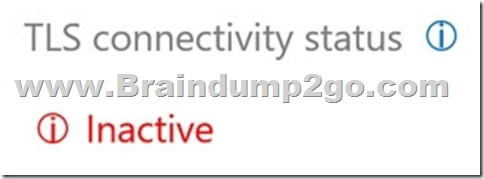
What is a possible cause of the issue?
A. The firewall blocks traffic on port 5067
B. Location-Based Routing is enabled for the SBC.
C. Calling plan licenses are not assigned to users.
D. The SIP options are disabled.
Answer: A
Explanation:
One important point to note over here is that the SIP signaling port that is present by default is port 5067. The Direct Routing SIP Trunk can be configured only by using a TLS connection.
Reference:
https://ezcloudinfo.com/2021/01/19/part-2-configure-audiocodes-sbc-for-microsoft-teams-direct-routing/
QUESTION 64
You have a Microsoft 365 tenant that has Modern authentication enabled for an services Multi-factor authentication (MFA) is enforced for all users.
You are deploying Microsoft Teams Rooms.
The first time you attempt to sign in to a Teams Rooms, you receive an error message indicating that the device cannot sign in to Teams.
You verify that Modern authentication is enabled in Teams Rooms.
What prevents you from signing in?
A. The Microsoft Authenticates app is not configured for the Teams Rooms account.
B. The Teams Rooms account is not licensed for Microsoft intune.
C. Teams Rooms must be domain joined first.
D. MFA is unsupported In reams Rooms.
Answer: D
Explanation:
Because Microsoft Teams Rooms uses resource owner password credentials authorization and the underlying REST APIs for modern authentication, the following are important differences to be aware of that are specific to Microsoft Teams Rooms.
* MFA isn’t supported regardless of the topology you have.
* Etc.
Reference:
https://docs.microsoft.com/en-us/microsoftteams/rooms/rooms-authentication
QUESTION 66
You need to provide Microsoft Teams users with the ability to perform PSTN calling through a Session Border Controller (SBC).
Which licenses can you assign to achieve the goal?
A. Microsoft 365 E3 or Microsoft 365 E5
B. Microsoft 365 E5 or Office 365 E5
C. Office 365 E3 or Microsoft 365 E3
D. Office 365 E3 or Office 365 E5
Answer: B
Explanation:
To achieve this Teams license and Phone System license are required. Both are provided only in E5 (both Office and Microsoft 365 products). In E3 versions, there is no phone system license, and would have to be assigned separately.
https://docs.microsoft.com/en-us/azure/active-directory/enterprise-users/licensing-service-plan-reference
QUESTION 67
Hotspot Question
You are deploying Microsoft Teams Calling Plans to three users as shown in the following table.

You need to resolve the issues.
What should you assign to each user? To answer, select the appropriate options in the answer area.
NOTE: Each correct selection is worth one point.
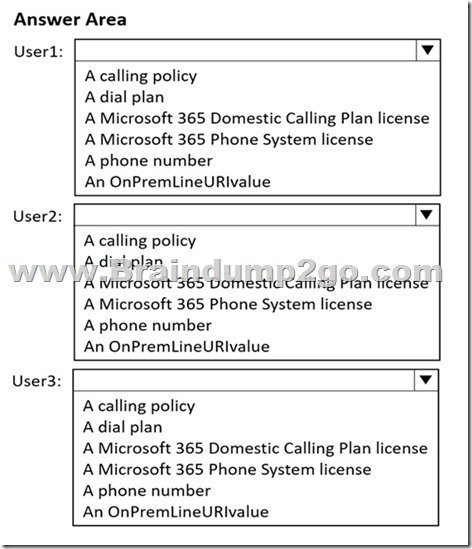
Answer:
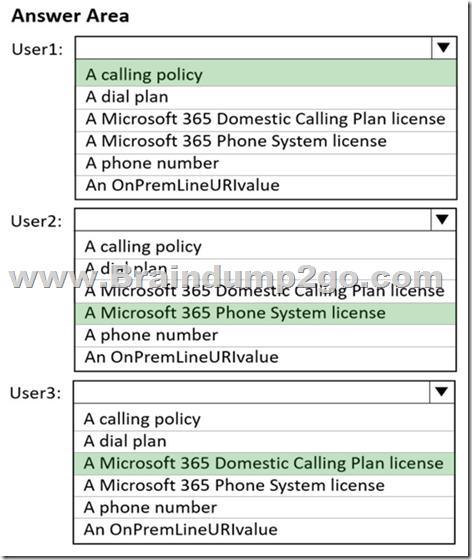
QUESTION 68
Your company has an office in Seattle.
The default dial-in number for the company’s Microsoft Teams meetings has an area code of 425.
The company does NOT have an office in New York. However, most of the company’s customers are in New York.
You need to get a new default dial-in number that has a local 718 area code.
You will NOT define additional location information in Teams.
Which two actions should you perform before you assign the bridge? Each correct answer presents part of the solution.
NOTE: Each correct selection is worth one point.
A. Get a Dedicated conference bridge (Toll) number.
B. Search for new numbers by using a 718 area code.
C. Get an auto attendant toll-free number.
D. Get a Dedicated conference bridge (Toll Free) number.
E. Search for new numbers by using New York.
Answer: AB
Explanation:
A: Change the default phone number of your conference bridge (optional).
The default phone number of your conference bridge defines the caller ID that will be used when an outbound call is placed by a participant or the organizer from within a meeting.
Only a service toll number can be set as the default number for your conferencing bridge; service toll-free numbers can’t be set as the default number of your conferencing bridge. If you are assigning a service toll number and you would like to set it as the new default number for your audio conferencing bridge, perform these steps:
1. On the left navigation pane, go to Meetings > Conference bridges.
2. Highlight the service toll number that you want to configure as the default.
3. Select Set as default.
B: Note: In addition to?€‰getting phone numbers for your users, you can get toll or toll-free phone numbers for services such as Audio Conferencing (for conference bridges), Auto Attendants, and Call Queues (also called service numbers). Service phone numbers have a higher concurrent calling capacity than user or subscriber phone numbers. For example, a service number can handle hundreds of calls simultaneously, whereas a user’s phone number can only handle a few calls simultaneously. To get service numbers, contact your operator.
Reference:
https://docs.microsoft.com/en-us/microsoftteams/change-the-phone-numbers-on-your-audio-conferencing-bridge
QUESTION 69
You have a Microsoft Teams Phone deployment that is used in the United States.
You need to ensure that emergency calls placed to 9911.
What should you configure?
A. a dial plan normalization rule
B. an emergency calling policy
C. an emergency call routing policy
D. an outbound PSTN number translation rule
Answer: C
QUESTION 70
You are migrating users from Microsoft Skype for Business to Microsoft Teams.
You plan to create an auto attendant that can be used by all the users during the migration.
You need to create the resource account for the auto attendant.
What should you use?
A. the Resource accounts node in the Microsoft Teams admin center
B. the Users node in the Microsoft 365 admin center
C. the New-CsHybridApplicationEndpoint cmdlet
D. the New-CsOnlineApplicationEndpoint cmdlet
E. the New-CsOnlineApplicationlnstance cmdlet
Answer: E
Explanation:
The New-CsOnlineApplicationInstance cmdlet is used to create an application instance in Azure Active Directory. This same cmdlet is also run when creating a new resource account using Teams Admin Center.
Example:
New-CsOnlineApplicationInstance -UserPrincipalName [email protected] -ApplicationId ce933385-9390-45d1-9512-c8d228074e07 -DisplayName
“AppInstance01”
This example creates a new application instance for an Auto Attendant with UserPrincipalName “[email protected]”, ApplicationId “ce933385-9390-
45d1-9512-c8d228074e07″, DisplayName “AppInstance01” for the tenant.
The application ID’s that you need to use while creating the application instances are:
Auto Attendant: ce933385-9390-45d1-9512-c8d228074e07 Call Queue: 11cd3e2e-fccb-42ad-ad00-878b93575e07
Note:
Cmdlets to manage resource accounts:
New-CsOnlineApplicationInstance –
Find-CsOnlineApplicationInstance
Get-CsOnlineApplicationInstance –
Set-CsOnlineApplicationInstance –
New-CsOnlineApplicationInstanceAssociation
Get-CsOnlineApplicationInstanceAssociation
Remove-CsOnlineApplicationInstanceAssociation
Get-CsOnlineApplicationInstanceAssociationStatus
Reference:
https://docs.microsoft.com/en-us/powershell/module/skype/New-CsOnlineApplicationInstance
Resources From:
1.2023 Latest Braindump2go MS-720 Exam Dumps (PDF & VCE) Free Share:
https://www.braindump2go.com/ms-720.html
2.2023 Latest Braindump2go MS-720 PDF and MS-720 VCE Dumps Free Share:
https://drive.google.com/drive/folders/15TnByDHFbDYBfo3i7KBlEq5WPnBo6njT?usp=sharing
3.2023 Free Braindump2go MS-720 Exam Questions Download:
https://www.braindump2go.com/free-online-pdf/MS-720-PDF-Dumps(Q30-Q70).pdf
Free Resources from Braindump2go,We Devoted to Helping You 100% Pass All Exams!





